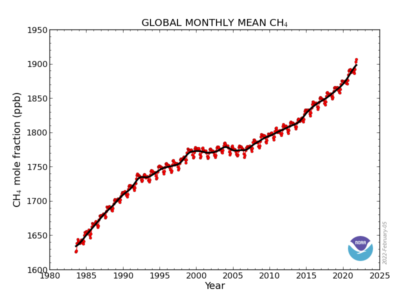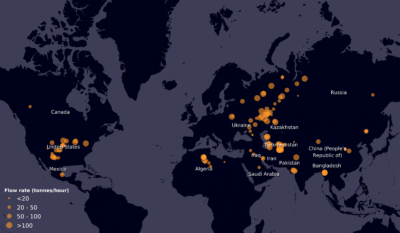A sudden surge in methane emissions is threatening to undermine international efforts to halt planetary warming at 1.5 degrees Celsius. And scientists are warning that the task of holding back the surge is being made worse because climate negotiators are underestimating by a factor of three the warming effect that methane will have over the critical quarter-century we have left to reach net-zero emissions under the 2015 Paris Agreement.
As a result, scientists say, governments are giving far too little attention to curbing methane by measures such as plugging abandoned gas wells, sealing pipelines, covering up landfills, and preventing crop waste.
The problem arises because of a long-standing convention that the warming effect of emissions of different planet-warming gases is measured according to their average impact over 100 years. Scientists say that was fine when the world was focused on stabilizing temperatures by the end of the century. But now that the target is to halt warming at a level that will be reached by mid-century, it is no longer fit for purpose because it drastically underestimates the importance of methane, which typically lasts little more than a decade in the air but has most of its warming impact in that time.
In recent weeks, two new studies have called on climate negotiators to adjust their formulae for comparing different greenhouse gases to make it consistent with the timeline of the Paris Agreement. Sam Abernethy, a physics PhD student at Stanford University, says that the adjustment, which would put more emphasis on methane emissions, could reduce peak temperatures in mid-century by up to 0.2 degrees C (0.36 degrees F).
“We are severely undervaluing methane. We need drastic action in the short term to achieve our goals,” says one scientist.
“The more aggressive the temperature goal, the more important potent, short-lived greenhouse gases such as methane become,” says Rob Jackson, professor of energy and environment at Stanford University. In a new analysis with Abernethy, Jackson calculates that measured on a timeframe to the mid-2040s — the likely deadline for capping warming under the Paris Agreement — methane is three times more important than assumed under existing regulations.
“We are severely undervaluing methane,” says Abernethy. “We need drastic climate action in the short term to achieve our Paris Agreement goals. Methane is the best lever to make that happen.”
This will require action against not just leaks from oil and gas infrastructure, but also the many biogenic sources, such as landfills and livestock. But achieving that is being undermined by what Abernethy calls the “arbitrary and unjustified” timeframe under which regulators currently assess the gas.
A second new study suggests that negotiators should create a separate target for cutting methane emissions. But some scientists caution against placing too much emphasis on reaching short-term temperature targets by action on methane if that were to lead to higher CO2 emissions that produce longer-term warming.
Two-fifths of methane emissions come from natural sources, such as microbes in wetlands, and the remainder from human activities ranging from landfills and flooded rice fields, to the guts and manure of cattle, to venting from coal mines and leaks from gas and oil wells and pipelines, according to leading analyst Euan Nisbet of Royal Holloway, University of London.
Global methane concentrations since 1983.
NOAA
A new analysis of industrial methane emissions published this week by the International Energy Agency (IEA) highlighted the importance of unrecorded emissions leaking from coal mines.
Thanks to constantly rising emissions, the concentration of methane in the atmosphere has almost tripled since preindustrial times — a far bigger increase than for the most important gas, carbon dioxide. Last month, the U.S. National Oceanic and Atmospheric Administration published data showing a record jump in 2021 to 1,900 parts per billion, compared to a preindustrial level of 700 parts per billion. The gas is responsible for around 30 percent of current warming, according to the IEA.
The technical challenges of curbing methane will be diverse, ranging from capping abandoned oil wells to breeding cattle that produce less methane, to providing incentives for farmers to stop burning crop waste. But current regulations covering greenhouse gases are ill-suited to the task.
International agreements for net-zero emissions bundle together all greenhouse gases, including methane, with their warming effect assessed according to their “CO2 equivalent,” as measured over 100 years. This gives maximum flexibility for countries to meet their Paris promises. But scientists say it is misleading and potentially dangerous because it ignores the different lifetimes of the gases.
Most of the CO2 released today will stick around in the atmosphere and have a continued warming effect over many centuries. Methane releases, however, have a big impact over the first decade, but then quickly disappear. The convention of averaging out the warming impacts of each gas over 100 years camouflages the bigger but more short-term impact of methane. The comparison is, in effect, tuned to maximize the impact of CO2 and minimize the impact of methane.
The U.S. has announced plans to spend more than a billion dollars tackling “super-polluting methane emissions.”
Partly as a result, methane has until recently been largely neglected by climate-change scientists and regulators, who have concentrated on assessing and curtailing CO2. But that is starting to change as concern grows about the short-term impact of methane.
At the Glasgow climate conference last November, the Biden administration and the European Union, representing two of the world’s top five methane emitters, launched a Global Methane Pledge aimed at cutting emissions by 30 percent by 2030.
To date, 111 nations have signed the pledge. Notable absentees include India, Russia, and China, which is alone responsible for almost a third of global emissions. However, methane reductions did feature strongly in the U.S.-China Glasgow Declaration, under which China agreed to develop an action plan that would have a “significant effect” on its methane emissions this decade. Activists keen to see whether China lives up to that will be looking to a promise in the declaration that the two nations would “convene a meeting in the first half of 2022 to focus on the specifics of enhancing measurement and mitigation of methane.”
For its part, the White House last month announced plans to spend more than a billion dollars tackling what it calls “super-polluting methane emissions” — mainly leaks from the country’s 130,000-plus abandoned gas and oil wells. A recent survey in Texas and New Mexico found that just 30 old wells were releasing around 100,000 tons of methane annually.
Outside the United States, the largest concentrations of these super-sources are in oil and gas fields in Russia and Turkmenistan. The latter — another no-show on the Global Methane Pledge — is a secretive gas-rich Central Asian state beset by old Soviet-era technology. According to analysis of satellite sensors of methane plumes data made by Kayrros, a Paris-based data analytics company, 31 of the 50 most severe methane releases from onshore oil and gas operations worldwide in 2019 were from Turkmenistan.
Other major emitters from oil and gas installations identified by the IEA include Iran, Venezuela, Algeria, Iraq, and Saudi Arabia.
The good news is that, once they are identified, these “super sources” can usually be shut cheaply, by plugging wells and sealing leaks in pipelines. Many such measures could deliver financial gains through the sale of the saved methane. In a study of the Kayrros data published in Science in February, Thomas Lauvaux of Penn State University and colleagues estimated plugging leaking wells and pipelines could benefit Turkmenistan by $6 billion a year. “At today’s elevated gas prices, nearly all the emissions from oil and gas operations worldwide could be avoided at no net cost,” said IEA Executive Director Fatih Birol.
The U.S.-EU methane-reduction pledge was supported by funding bodies such as the European Bank for Reconstruction and Development, the European Investment Bank, and the UN Green Climate Fund, which promised to work with the U.S. and EU to provide aid for countries aiming to meet their climate commitments through cutting methane emissions.
“Soaring methane emissions are now primarily the result of faster-growing biogenic sources,” such as agriculture, notes an expert.
But the bad news is that fixing these big concentrated sources of methane won’t be enough to curb rising emissions. While the IEA estimates that the coal, oil, and gas industries may be responsible for around 40 percent of methane emissions from human activity, isotopic analysis, which can distinguish different sources of methane according to the ratios of carbon-12 to carbon-13, shows that they are not the main source of a rapid increase in emissions seen over the past 15 years.
“Although fossil fuel emissions may still be growing, soaring methane emissions are now primarily the result of faster-growing biogenic sources,” according to Nisbet. Most of the increase has been from natural wetlands, flooded rice fields, landfills, and livestock in the tropics. There is growing concern that this surge may be a feedback from climate change, as a warmer and wetter environment increases the activity of methane-generating microbes.
Climate scientists have long warned that melting permafrost in Arctic regions could in the future release massive amounts of frozen methane, unleashing further warming. But it now seems that tropical wetlands are already doing much the same thing. “Is warming feeding warming? It seems likely,” says Nisbet.
So the effort to halt emissions will have to be wide-ranging. There is technology to remove methane from the air where it concentrates in confined spaces, such as coal-mine ventilation systems or cattle barns. Landfills can be treated like gas reserves and tapped for their fuel, and where that is not possible, covered to prevent emissions, he says.
A farmer walks through a rice field in Assam, India. Flooded rice fields are a significant source of methane emissions.
Biju Boro / AFP via Getty Images
Halting the burning of crop waste by farmers, reducing the time that rice fields are flooded, and breeding cattle that produce less methane have all been proposed as ways to remove agricultural sources.
But climate scientists say that the downplaying of methane in the formulae for assessing the warming potential of different greenhouse gases reduces the incentives for governments to invest in making such reductions. That’s because such efforts will contribute only a small amount to cutting emissions to the target of “net zero.”
To beat this trap, one international group of researchers, led by Myles Allen of the University of Oxford, in January called for replacing the single 100-year “CO2 equivalent” target with two targets — one for emissions of long-term gases such as CO2 and the other for the short-term gases, principally methane.
That makes sense, says Abernethy. But, even with two targets, the different gases at some point have to be compared, based on their impacts on the climate. “We need a way to value reductions in one bucket compared to reductions in the other bucket,” says Abernethy. “We argue that it should be weighting based on their impact on achieving the Paris Agreement.”
Abernethy’s new analysis provides the metric for doing that, by working out exactly how much greater the methane warming effect is over the years that matter for fulfilling the Paris Agreement. It shows that, over the period to 2045, methane molecules emitted now will be 75 times more potent in warming the atmosphere than CO2 molecules emitted at the same time. This compares with the figure of 28 currently used by UN negotiators, and 25 still in use by the U.S. Environmental Protection Agency.
If funds “are spent on methane cuts instead of CO2 cuts, temperatures will be lower in the short term, but higher in the long term,” an analyst warns.
Some researchers question the advisability for the long run of giving too much attention to short-term calculations that prioritize cutting methane emissions. “If limited funds are spent on methane cuts instead of CO2 cuts, then temperatures will be lower in the short term, but higher in the long term,” warns Michelle Cain, environmental data analyst at Cranfield University.
Abernethy agrees that Cain has a point. His own quarter-century time framing is as scientifically arbitrary as the conventional one-century framing, he admits. “But at least it is consistent with international policymaking priorities.”
Most other climate scientists spoken to for this article took a similar view and backed Abernethy’s approach. Keith Shine, a meteorologist at the University of Reading and co-author of Allen’s paper, says that making the calculations about the warming effect of different gases consistent with international climate priorities “opens the door to more informed, and cost-effective, policy choices.”
But although the recalibration to emphasize methane reductions is supported by much of the climate-science community, it remains to be seen whether it will find favor among climate negotiators. There is no formal proposal to the UN climate convention from any government to make the change. And any such proposal would be contentious, because it would have important implications for how countries reduce their emissions. There would be winners among countries with good potential to cut methane and losers among those without.
Shine is doubtful that negotiators will want to open that can of worms. He says the UN political process “is much more conservative, and appears irreversibly committed to using the 100-year timeframe, in spite of much evidence that it is not fit for the purpose of meeting temperature targets.”
If so, then halting the warming of the planet any time soon just got harder.



